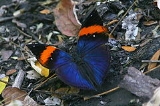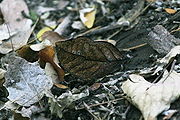
Kallima inachus
Encyclopedia
The Orange Oakleaf or Dead Leaf (Kallima inachus) is a nymphalid
butterfly found in tropical Asia
from India
to Japan
. With wings closed, it closely resembles a dry leaf with dark veins and is a spectacular example of camouflage
.
_at_samsing,_duars,_west_bengal_w_img_6241.jpg) The dry and wet season butterflies differ
The dry and wet season butterflies differ
in colouration.
, interspace 1a, 1 to near apex, basal half of 2, and extreme bases of 3 and 4 rich violet-blue, the borders of the discocellulars and the interspaces of veins 2, 3 and 4 are black, spread diffusely outwards in interspaces 1a and 1. A very broad oblique discal orange band from costa to apices of interspaces 1 and 2, this orange band is sprinkled with bluish black scales ; apical third of wing velvety purpurescent black; a hyaline transverse spot near middle of interspace 2, and a subtriangular similar small preapical spot. Hind wing more uniform violescent blue ; the costal margin and apex very broadly brown, somewhat densely irrorated with dusky violescent black scales ; dorsal margin brown ; a ridge of long brownish hairs along vein 1 spreading on to the dorsal margin. Fore and hind wings crossed by a subterminal dusky zigzag line commencing about the middle of interspace 3 in the fore wing, and most conspicuous on the hind wing.
 Underside very closely resembles a dry leaf ; ground-colour very variable, but usually some shade of brown (rusty, greyish, and yellowish browns being the most common), always with scattered dark dots or little dark patches having the appearance of fungus-like or lichenous growths so common on dead leaves in the tropics. When the insect closes its wings over its back the likeness to a dead leaf is most striking, and is heightened by a straight transverse, narrow, dark band running from the apex of the fore to the tornus
Underside very closely resembles a dry leaf ; ground-colour very variable, but usually some shade of brown (rusty, greyish, and yellowish browns being the most common), always with scattered dark dots or little dark patches having the appearance of fungus-like or lichenous growths so common on dead leaves in the tropics. When the insect closes its wings over its back the likeness to a dead leaf is most striking, and is heightened by a straight transverse, narrow, dark band running from the apex of the fore to the tornus
of the hindwing, often with oblique narrower similar bands or lines given off from it, all simulating very closely the midrib and lateral veins of a leaf. The hind wing in all specimens has a more or less obsolescent or faint series of postdiscal ocelli
, traces of which are also apparent on the fore wing. Antennae dark brown; head, thorax, and abdomen dark violescent brown; beneath, the palpi, thorax and abdomen paler earthy brown.
)
Nymphalidae
The Nymphalidae is a family of about 5,000 species of butterflies which are distributed throughout most of the world. These are usually medium sized to large butterflies. Most species have a reduced pair of forelegs and many hold their colourful wings flat when resting. They are also called...
butterfly found in tropical Asia
Asia
Asia is the world's largest and most populous continent, located primarily in the eastern and northern hemispheres. It covers 8.7% of the Earth's total surface area and with approximately 3.879 billion people, it hosts 60% of the world's current human population...
from India
India
India , officially the Republic of India , is a country in South Asia. It is the seventh-largest country by geographical area, the second-most populous country with over 1.2 billion people, and the most populous democracy in the world...
to Japan
Japan
Japan is an island nation in East Asia. Located in the Pacific Ocean, it lies to the east of the Sea of Japan, China, North Korea, South Korea and Russia, stretching from the Sea of Okhotsk in the north to the East China Sea and Taiwan in the south...
. With wings closed, it closely resembles a dry leaf with dark veins and is a spectacular example of camouflage
Camouflage
Camouflage is a method of concealment that allows an otherwise visible animal, military vehicle, or other object to remain unnoticed, by blending with its environment. Examples include a leopard's spotted coat, the battledress of a modern soldier and a leaf-mimic butterfly...
.
Description
_at_samsing,_duars,_west_bengal_w_img_6241.jpg)
Polyphenism
A polyphenic trait is a trait for which multiple, discrete phenotypes can arise from a single genotype as a result of differing environmental conditions.-Definition:A polyphenism is a biological mechanism that causes a trait to be polyphenic...
in colouration.
The dry-season form
The fore wing discoidal cellGlossary of Lepidopteran terms
This glossary describes the terms used in the formal descriptions of insect species, jargon used mostly by professionals or entomologist....
, interspace 1a, 1 to near apex, basal half of 2, and extreme bases of 3 and 4 rich violet-blue, the borders of the discocellulars and the interspaces of veins 2, 3 and 4 are black, spread diffusely outwards in interspaces 1a and 1. A very broad oblique discal orange band from costa to apices of interspaces 1 and 2, this orange band is sprinkled with bluish black scales ; apical third of wing velvety purpurescent black; a hyaline transverse spot near middle of interspace 2, and a subtriangular similar small preapical spot. Hind wing more uniform violescent blue ; the costal margin and apex very broadly brown, somewhat densely irrorated with dusky violescent black scales ; dorsal margin brown ; a ridge of long brownish hairs along vein 1 spreading on to the dorsal margin. Fore and hind wings crossed by a subterminal dusky zigzag line commencing about the middle of interspace 3 in the fore wing, and most conspicuous on the hind wing.

Glossary of Lepidopteran terms
This glossary describes the terms used in the formal descriptions of insect species, jargon used mostly by professionals or entomologist....
of the hindwing, often with oblique narrower similar bands or lines given off from it, all simulating very closely the midrib and lateral veins of a leaf. The hind wing in all specimens has a more or less obsolescent or faint series of postdiscal ocelli
Ocellus
A simple eye refers to a type of eye design or optical arrangement that contains a single lens which detect light. A "simple eye" is so-called in distinction from a multi-lensed "compound eye", and is not necessarily at all simple in the usual sense of the word...
, traces of which are also apparent on the fore wing. Antennae dark brown; head, thorax, and abdomen dark violescent brown; beneath, the palpi, thorax and abdomen paler earthy brown.
Wet-season form
Smaller than the dry-season form, but very similar to it. The colours are richer and darker, and the orange discal band more broadly bordered with black on the inner side. On the underside some of the specimens from areas of heavy rainfall have the ground-colour very dark ochraceous brown.Distribution
The Himalayas, from Kashmir to Sikkim at low elevations; Orissa; Eastern Ghats; Pachmarhi, Amarkantak; the lower hills of Assam, Burma, and Tenasserim.Food plants
The larvae feed on plants such as Girardinia diversifolia (Urticaceae), Polygonum orientale (Polygonaceae), Prunus persica (Rosaceae), Hygrophila salicifolia (Acanthaceae ), Lepidagathis formosensis (Acanthaceae) and species of Strobilanthes (Acanthaceae) including Strobilanthes capitatus, Strobilanthes flaccidifolius, Strobilanthes glandulifera, Strobilanthes pentastemonoides, Strobilanthes tashiroi.Larva
"Velvety black, covered with rather long yellowish hair. All the spines reddish." Of these last it is stated that there are eleven on each segment, a dorsal, two subdorsal and three lateral on each side.Pupa
"Simple. Thorax slightly keeled ; abdomen with small dorsal conical points. Colour pale brownish buff, variegated with slaty irrorations." (G. C. Dudgeon quoted by Frederic MooreFrederic Moore
Frederic Moore FZS was a British entomologist. It has been said that Moore was born at 33 Bruton Street but may be incorrect given that this was the address of the menagerie and office of the Zoological Society of London from 1826 to 1836.Moore was appointed an assistant in the East India Company...
)

